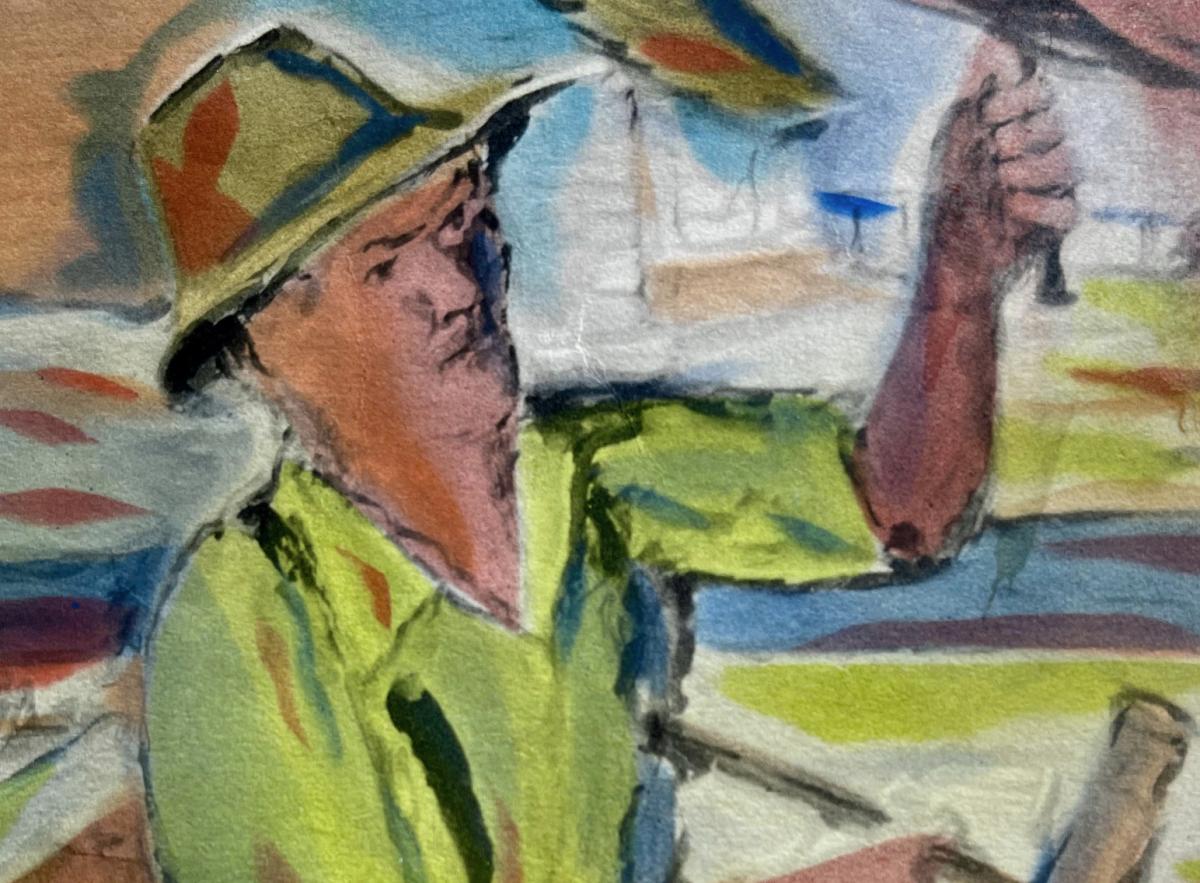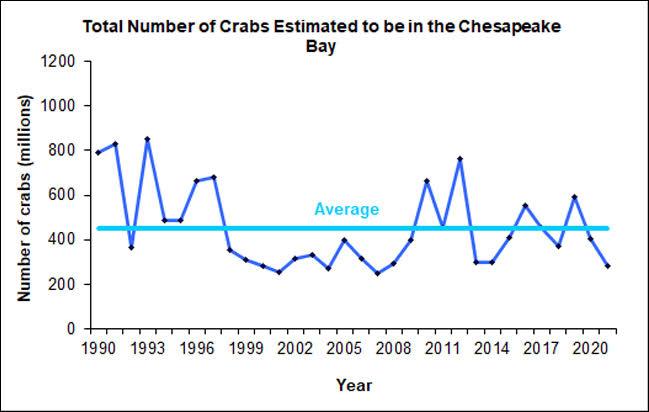“Ninety- three species, which included invertebrates, fish, reptiles, birds, and mammals, were documented to prey upon blue crabs. … More fish species were identified as blue crab predators than any other taxonomic group (67).” – From A Review of Blue Crab Predators, by Vincent Guillory and Megan Elliott, Louisiana Department of Wildlife and Fisheries
Include human beings in that mammal category. In fact, we probably top the list. And why not? Who doesn’t like crab meat – its texture and flavor so delicate and sweet?

Titled Captain Billy, this watercolor illustration by artist Jack Lewis appears in Gilbert Byron’s 1942 collection of poetry These Chesapeake Men. It shows Captain Billy involved in the tedious process of caulking the seams of the planks on the bottom of his workboat.
No wonder they’re so feisty, snapping and clacking with those Edward Scissor-Hands claws at anything or anybody that comes within range. Their all-seeing stereoscopic eyes miss little.
Blue crabs are constantly being preyed upon, chased after, crunched when hard, chewed and savored when soft. In their 24-36 month life spans, except when tucked into their muddy beds in the winter months, the crabs swim constantly, knowing instinctively their trademark blue, white and green colors amount to nothing less than a bullseye target.
All of this prattle because the Chesapeake harvest has switched completely now from oysters to crabs. The dominant buzz up and down the Bay surrounds the shortage of crabs so far, with watermen still getting $200 per bushel and more – for what few crabs they can catch – and veteran seafood people scratching their heads. $60 to $120 per dozen depending on size? What’s going on?
Some say it’s shedding time again and crabs aren’t biting as much. Others wonder about skates and rockfish and porpoises staking their claim.
Still others point to the results of the annual Winter Dredge Survey that provides annual estimates of how many crabs are in the Chesapeake system.
Scientists at Maryland’s Department of Natural Resources (DNR) and Virginia’s Institute for Marine Sciences (VIMS) work on the survey each year, dragging dredges through the bottom, up and down the length of the Bay, to catch samples and then spin those numbers out to gain perspective.
Crab populations, of course, vary widely from year to year based on all kinds of variables including how the winds blow off the ocean where early stages of crab life – larvae and megalops by the billion – populate the water column. Onshore winds at certain times of the year can mean more crabs in the Chesapeake and vice versa.
But about those 2020-2021 survey results. Compared to the 2019-2020 survey, this year’s samples from all over the Bay showed a significant decrease in the number of juvenile crabs available to grow to market size as they go through a few sheds in the summer and fall. That decrease – in the 30 percent realm – appears to point directly at scarcer crabs to catch now and through the summer and fall.
For the longer term, however, managers say the survey showed a healthy level of female numbers, at least double the 70-million number below which the blue crab fishery could drop into the unsustainability range. Total female population found this year was lower than last year’s survey, but still at healthy levels.
In the meantime I’m trying to track down how many crabs were harvested in 2020 compared to how many crabs were estimated to be in the Chesapeake for that year.
Right now it’s estimated there are about 300 million crabs in the Bay. The most recent number I found for total harvest was from 2019 when an estimated 61 million pounds were taken. I’m working on finding out how many crabs make a pound. Stay tuned.
Crisfield waterman Hon Lawson once said: “Scarce oysters don’t get no scarcer.” Let’s hope the same goes for crabs.
Here’s a blue crab poem by Delmarva novelist, poet, columnist and son-of-a-waterman Gilbert Byron who grew up in Chestertown, taught in Dover and Lewes, and then lived for several decades near St. Michaels. The poem first appeared in Byron’s 1942 collection of poems: These Chesapeake Men.
CRAB TALK
Mama sent me
To get the crabs
From old Benny,
Down on the creek
Where the shanty men seek
Happiness.
He was mending eel pots,
Tar and twine,
And deft seine needle,
Chewing tobacco,
Spitting fine,
Whistling softly.
He couldn’t even see,
Little boys like me.
I heard them scratching
In a covered basket.
Shyly I whispered,
Scared almost dead,
“Are those the crabs, Captain Ben?”
Rolling an eye, he grunted,
“Them’s them,”
That’s all he said,
“Them’s them.”
by Gilbert Byron
Dennis Forney grew up on the Chester River in Chestertown. After graduating Oberlin College, he returned to the Shore where he wrote for the Queen Anne’s Record Observer, the Bay Times, the Star Democrat, and the Watermen’s Gazette. He moved to Lewes, Delaware in 1975 with his wife Becky where they lived for 45 years, raising their family and enjoying the saltwater life. Forney and Trish Vernon founded the Cape Gazette, a community newspaper serving eastern Sussex County, in 1993, where he served as publisher until 2020. He continues to write for the Cape Gazette as publisher emeritus and expanded his Delmarva footprint in 2020 with a move to Bozman in Talbot County.






Write a Letter to the Editor on this Article
We encourage readers to offer their point of view on this article by submitting the following form. Editing is sometimes necessary and is done at the discretion of the editorial staff.